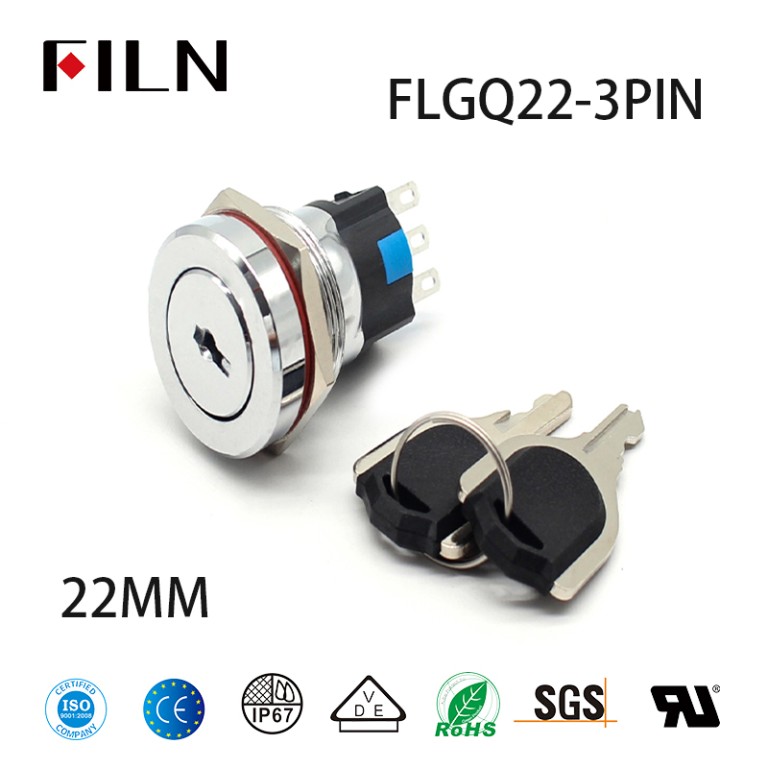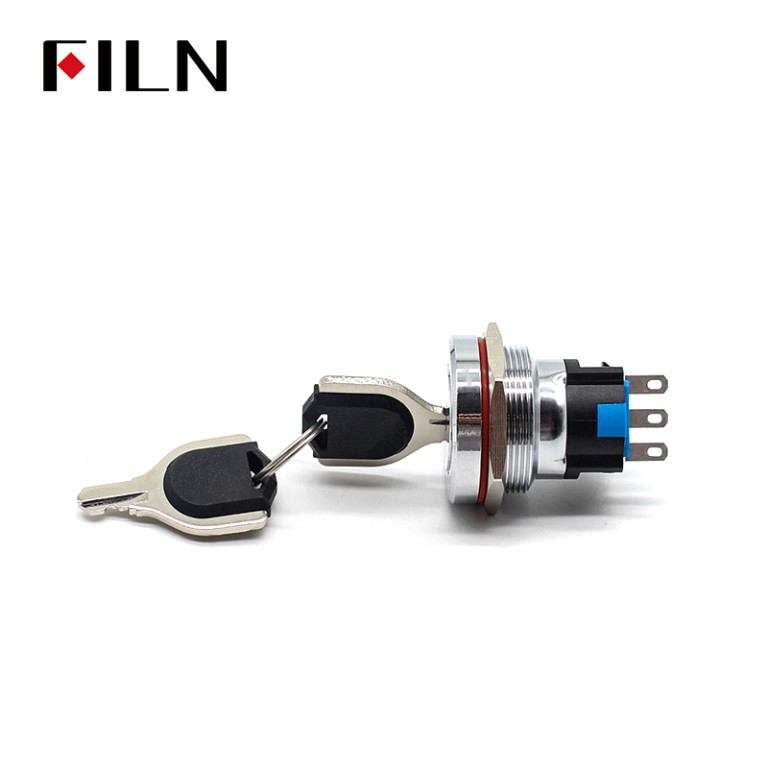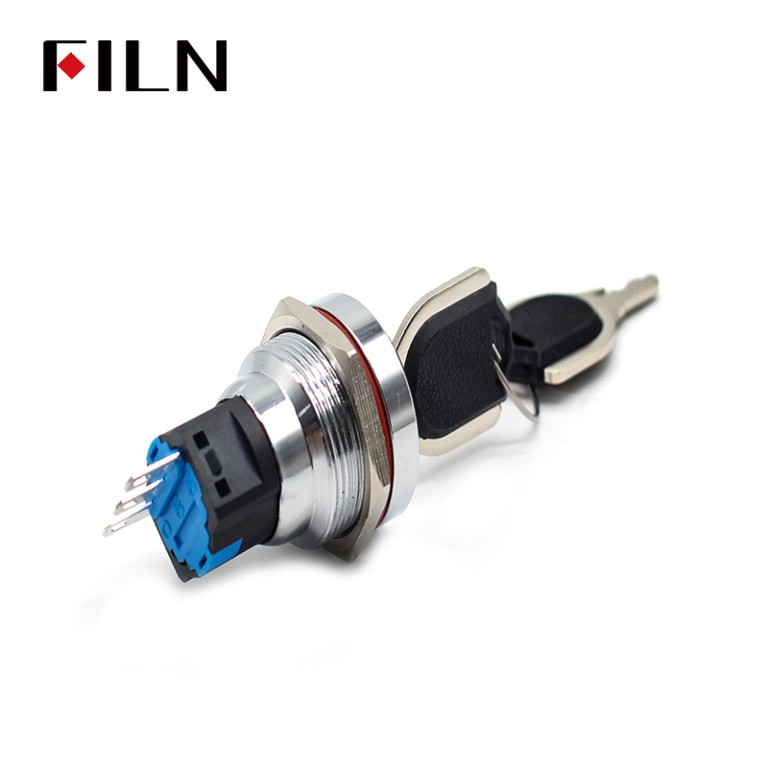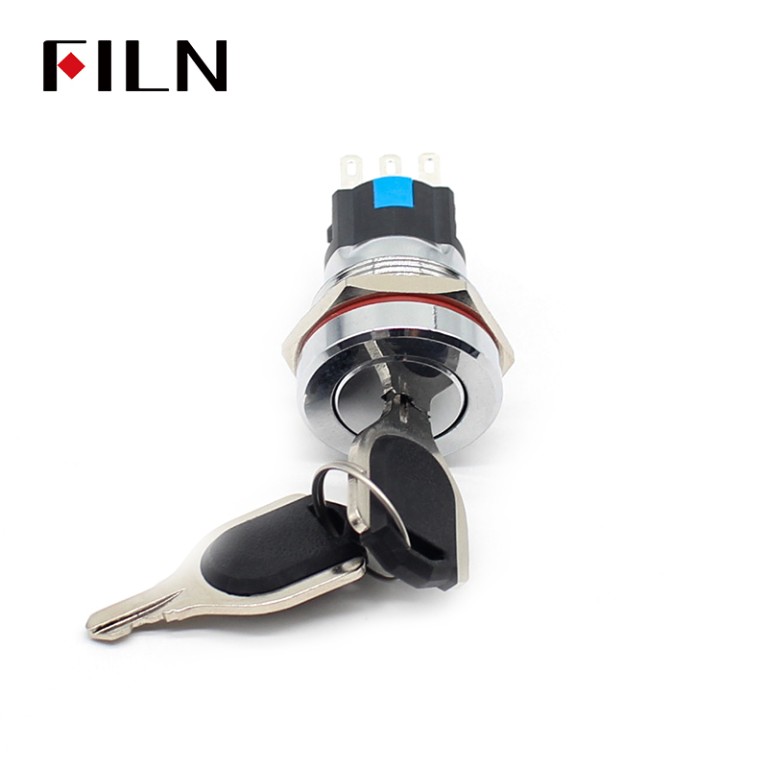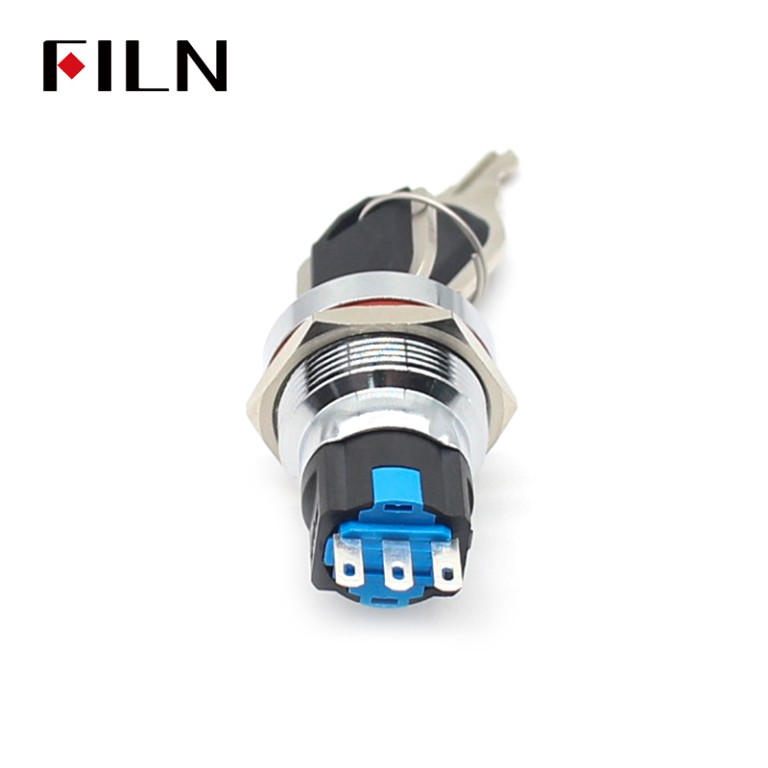Product Drawings:
The Ultimate Guide to Pin Push Buttons: Answering Your Top Questions
- Name:Pin Push Button
- Model:FLGQ22
- Head Type:Flat Head
- Size:22mm
- Switching Functions:Momentary
- Contact Configuration:1NO
- Rated Voltage: 1A(DC)0.5A(AC)
- Voltage Options:36V(DC) 250(AC)
- Material:ABS plastic, Plastic
- Download Certification:CE, CCC, ROSH, UL
- Email:inquiry@cnylin.com.cn

Product Parameters:
| Production Series | FLGQ22 | Light Guide Button | |
| Button Shape | round | Actuator | ABS plastic |
| Button LED Color | Housing Sleeve | ABS plastic | |
| Mechanical Life | The 500 thousand time | Button Pin | 22AWG PVC wire(0.3MM2) |
| Electrical Life | The 100 thousand time | Rubber Ring | SIL silica gel |
| Protection Level | Nut | H59 nickel plated brass | |
| Rated Voltage | 36V(DC) 250(AC) | Housing | ABS plastic |
| Rated Current | 1A(DC)0.5A(AC) | Light Source | |
| Rated Power | 36W(DC)125W(AC) | size | 22mm |
| Operating Temperature | -25℃~+85℃ | Contact | AgCdO12 |
How to wire a pin push button with led?
In electrical circuits, how you wire a pin push button can affect not only the operation of the switch itself but also connected devices. Here, we explain two different circuit configurations for a pin push button, focusing on LED indicators and device operation.
The wiring way is as follows, the first step, the positive pole of the power is connected to the NO pin, the second step, connect the negative pole of power to the C pin of the switch.
Video of other button switch wiring
Customization Advantages of FILN pin push button
The FILN pin push button is a versatile product that can be customized according to the needs of different customers. This flexibility opens up an array of advantages for users, making it a sought-after component in various applications.
Why Customization is Important for pin push button ?
Customization is not just a luxury but a necessity in the ever-competitive market. Manufacturers are under constant pressure to provide products that meet specific customer needs. In the case of the FILN pin push button, customization has a significant impact in terms of functionality, aesthetics, and adaptability.
- Industry requirements differ: Different sectors have different requirements for push button switches. For example, the medical industry might require switches that are easily sterilizable, while the automotive industry may need switches that can withstand harsh conditions.
- Consumer Preferences: End-users may prefer specific symbols or lights that make the switches easier to use or identify, enhancing the user experience.
- Technological Advances: As technology progresses, the requirement for switches also changes. Customization ensures that the product remains relevant.

Customizable Button Symbols
One of the most prominent features that can be customized in a FILN pin push button is the button symbol. Customers can opt for various light symbols depending on their specific needs.
- User Experience: A customized symbol can dramatically improve user experience by providing easy identification of the button’s function.
- Branding: Companies can also opt for symbols that align with their brand identity, ensuring consistency in product design.
- Regulatory Compliance: In some industries, there are specific symbols that are required by law to ensure safety and compliance.
Customizable Voltage Options
Another crucial aspect of customization is the voltage of the push button switch. FILN offers various voltage options, such as 110v push button switches, to cater to the varied needs of customers.
- Geographic Requirements: Different countries have different standard voltages. Custom voltage options allow for the global distribution of products.
- Device Compatibility: Customizable voltage ensures that the switches can be easily integrated into different systems without requiring additional components.
- Energy Efficiency: The ability to customize voltage can help in creating energy-efficient systems.
FILN’s commitment to customization offers not just product variety but also competitive advantage. Whether it’s custom symbols, voltages, or connectors, the pin push button can be tailored to meet the unique demands of your project, making it a smart choice for a multitude of applications.
Related products:
Table of Contents
1. What are the Different Types of Pin Push Buttons?
Pin push buttons come in various forms and functionalities. There are primarily two main categories: momentary and latching. Momentary buttons are only active when they are pressed, making them perfect for temporary actions like a reset button on a computer. Latching buttons, on the other hand, stay active after pressing until they are pressed again.
A Consumer’s Perspective
From a consumer’s standpoint, you may encounter pin push buttons in many household gadgets and electrical appliances, such as doorbells or flashlights.
An Electrician’s View
From an electrician’s point of view, pin push buttons are integral in control circuits. They serve as the user interface for many industrial machines.
Manufacturing Aspect
Manufacturers often design pin push buttons to be durable and resistant to elements such as water and dust. For in-depth information about various push button types, you can visit this link.
2. How Do You Wire a 2 Pin Push Button Switch Connection?
Wiring a 2 pin push button switch is usually straightforward. These switches have two pins: one for the input and the other for the output. Connect the input pin to the power source and the output to the device you wish to control.
DIY Enthusiast Point of View
For DIY enthusiasts, this is a simple weekend project that requires minimal components and tools. Just a pair of wire strippers and some basic electrical wire will do the trick.
Technician’s Perspective
Technicians often employ 2 pin push buttons in scenarios where there’s no need for a complex control system, such as turning on a light or a fan.
Manufacturer’s Angle
From a manufacturing perspective, 2 pin push button switches are easier and cost-effective to produce. They also require less quality control compared to more complex switches.
3. How Can You Use a 4 Pin Push Button Wiring Diagram?
A 4 pin push button is slightly more complicated because it usually involves an LED or some other feature that requires two additional pins. These are typically labeled as C1, C2, NO (Normally Open), and NC (Normally Closed).
For Novices
For beginners, a 4 pin push button wiring diagram serves as a visual guide to help set up the system. It’s essential to follow the instructions closely to avoid any errors.
Professional Electricians
Professional electricians often prefer 4 pin push buttons for complex machinery due to their versatility and extra features, such as LED indicators.
In Industrial Settings
In industrial setups, 4 pin push buttons are commonly used in control panels to visually indicate the status of a machine or system. For more information on 4 pin push button connections, check this link.
4. What is a Push Button Locking Pin?
A push button locking pin uses a button to release a locking mechanism, often used in applications where quick and easy adjustment is necessary.
In Everyday Objects
We encounter push button locking pins in many everyday objects, such as adjustable chairs and car seats, making adjustments quick and easy.
Mechanical Engineers
Mechanical engineers value push button locking pins for their simplicity and reliability, often employing them in machinery and construction.
Manufacturers
From a manufacturing point of view, push button locking pins can be made from a variety of materials, offering various levels of durability and resistance to environmental conditions.
5. What is a PCB Push Button Switch 4-Pin?
A PCB (Printed Circuit Board) push button switch with 4 pins usually has extra features like LED indicators. These are commonly used in electronic projects and consumer products.
In Electronics
In electronics, 4-pin PCB push buttons are popular because they can offer more features, such as lighting effects or additional input methods.
For Hobbyists
Hobbyists find 4-pin PCB push buttons to be highly versatile, allowing for more complicated projects that may include LED indicators or even simple screens.
In Production
When it comes to mass production, these types of switches are relatively easy to automate in the manufacturing process, which keeps costs down.
6. What is the Push Pin Locking Mechanism?
Push pin locking mechanisms use a pin that locks into place when the button is pressed and releases when the button is pressed again.
For End Users
For the end user, this mechanism provides a secure yet easily adjustable locking method for various applications, like baby gates or telescopic poles.
Designers
Designers appreciate the push pin locking mechanism because it is easy to integrate into products and offers both security and ease of use.
Manufacturers
Manufacturers favor this locking mechanism because it has fewer parts than traditional locking systems, making it easier and cheaper to produce.
7. What are Push Button Locking Pins for Tubing?
Push button locking pins for tubing are specifically designed to lock tubes and pipes into place, providing a secure connection that can easily be adjusted or disassembled.
For Home DIY Projects
For home DIY projects, push button locking pins for tubing offer a convenient way to build frameworks or plumbing systems that are both sturdy and adjustable.
Industrial Applications
In industrial applications, these types of pins are often used in settings where regular adjustments are necessary, such as in scaffolding or piping systems.
In Automotive
In the automotive industry, they are commonly used in places like car seat adjustments or to secure removable parts of a vehicle.
8. What Does a 4 Pin Push Button Switch Datasheet Tell You?
A 4 pin push button switch datasheet provides all the technical specifications you need to know, including electrical characteristics, mechanical life, and more.
For Product Designers
For product designers, the datasheet is invaluable for ensuring compatibility and performance in the end product.
For Technicians
Technicians use datasheets to understand the limitations and capabilities of a push button switch before installing it in a system.
For Purchasing Managers
Purchasing managers consult datasheets to make informed buying decisions based on the specifications and requirements of their projects. To find reliable datasheets, you can visit here.
9. How Do You Connect a 4 Pin Push Button Switch?
Connecting a 4 pin push button switch involves wiring the common pin, normally open, normally closed, and the LED or other additional features.
For DIYers
For DIYers, making sure to connect the wires to the correct pins according to the datasheet is essential for the system to work as expected.
Electrical Engineers
Electrical engineers often use these types of switches in complex systems, where they may be connected to a PLC or another advanced control system.
Industrial Use
In industrial settings, these switches are often used in control panels, providing not only a control mechanism but also status indicators for various processes.
10. What are the Common Applications of Push Button Quick Release Pins?
Push Button Quick Release Pins are used in a variety of applications where quick and easy adjustment is necessary, such as medical devices, sporting equipment, and machinery.
Medical Field
In the medical field, quick-release pins can be found in adjustable beds, wheelchairs, and other assistive devices.
Sporting Equipment
In sporting equipment,
these pins are used to quickly adjust the heights or lengths of devices like basketball hoops or gym machines.
Industrial Machinery
In industrial machinery, quick-release pins are often used to secure adjustable components, making them both versatile and practical for a variety of applications. For more insights on different types of push buttons, you can visit this link.
11. How Do Push Button Electrical Switches Work?
The basic mechanism of a push button electrical switch involves a simple circuit. When the button is pressed, it either makes or breaks a circuit, enabling or disabling the flow of electrical current.
Basic Understanding
For those with limited exposure to electrical components, it’s enough to understand that pressing the button changes the state of an electrical circuit—either enabling or disabling it.
Engineering Perspective
Engineers consider the internal structure of the switch, which often consists of springs and contacts that are engineered for reliable performance over long periods and in various environmental conditions.
In Manufacturing
Manufacturers focus on the materials and production processes that make these switches durable, reliable, and cost-effective. Electrical switches must undergo rigorous testing to ensure they meet specified performance standards.
For additional resources and types of electrical switches, you can refer to this link.
We hope this guide has been beneficial in answering some of the most commonly asked questions about pin push buttons. By exploring various points of view—from end users to technicians and manufacturers—we aim to provide a comprehensive understanding of this versatile component.
I apologize for the incomplete information. My article is not over yet, and I’ll continue to expand on the subject matter.
12. How Does a 4 Pin Push Button Switch Connection Work?
The 4 pin push button switch is a bit more complex than its 2 pin counterpart because it usually has additional features like an LED light. A typical 4 pin configuration would include two pins for the switch mechanism and two pins for the LED.
From a User’s Perspective
For an end-user, understanding a 4-pin connection might seem daunting, but it’s not much different from a 2-pin configuration. The additional pins are generally for extra features, not complications.
Technician’s Point of View
Technicians often prefer 4-pin switches for the additional functionality they offer. These pins can be configured for various purposes, such as status indicators, making them more versatile in complex circuits.
For Hobbyists and DIYers
If you’re into DIY projects, a 4-pin push button can add a level of sophistication to your build, allowing for features like status indicators. For more on 4-pin connections, check out this helpful resource.
This comprehensive guide has explored numerous aspects of pin push buttons, from their structure to their functionality and their diverse applications. Different perspectives, including those of end-users, technicians, engineers, and manufacturers, were considered to provide a well-rounded understanding of the subject. Whether you’re an amateur enthusiast or a seasoned professional, we hope this guide has been informative and useful.
I apologize for the inconvenience. The article is not yet complete, and I’ll continue to provide more valuable insights.
13. What are the Most Common Types of Push Button Locking Mechanisms?
Push button locking mechanisms can range from simple to complex, and their selection often depends on the application they’re intended for.
End-User Perspective
For an average person, the most visible locking mechanism might be the one that involves a simple twist or pull to lock in place. These are commonly seen in retractable pens or similar everyday objects.
Industrial Viewpoint
In an industrial setting, push button locking mechanisms are often far more complex and can involve magnetic or hydraulic systems for higher levels of security and reliability.
Product Designer’s Angle
From a product design perspective, the choice of locking mechanism can significantly impact the product’s usability and safety. The right choice can make the product intuitive and user-friendly, while the wrong choice could lead to user errors and potential accidents. For different types of push buttons with various locking mechanisms, you can refer to this resource.
14. How to Choose the Right 4 Pin Push Button Switch Datasheet?
Choosing the right datasheet for a 4 pin push button switch is essential for ensuring that the switch meets your specific requirements.
Buyer’s Perspective
From a buyer’s perspective, key parameters like voltage, current rating, and operational life are of utmost importance and should align with the project’s requirements.
Developer’s Viewpoint
Developers often look at more detailed parameters, like mechanical endurance and material type, to make sure the switch will perform reliably in the given application.
Manufacturer’s Angle
Manufacturers consider aspects like ease of production, cost, and compliance with standards to determine what details to include in the datasheet. For more detailed information on 4 pin push button switch datasheets.
The article will continue to address more questions to provide a comprehensive understanding of pin push buttons.
15. What Factors Affect the Longevity of a Push Button Locking Pin?
The longevity of a push button locking pin can be influenced by several factors, from materials used to the environment in which it operates.
Consumer Angle
From a consumer’s perspective, ease of use and durability are essential. A locking pin that’s made of high-quality materials and provides secure locking is likely to last longer.
Industrial Standpoint
In an industrial context, factors such as exposure to extreme temperatures, corrosive substances, or mechanical stress could significantly affect the longevity of a push button locking pin.
Manufacturer’s View
From the manufacturing angle, the focus is on material quality, precision engineering, and rigorous testing to ensure that the locking pin meets longevity standards. For a detailed explanation of different push button locking pins, you can refer to this link.
16. What Are the Best Practices for 4 Pin Push Button Switch Connection?
When it comes to connecting a 4 pin push button switch, there are some best practices to follow for optimal performance and safety.
DIY Enthusiast’s Perspective
For DIY enthusiasts, the key is to follow the wiring diagram carefully and to use appropriate tools for making secure connections. Proper soldering and wire stripping are essential steps.
Electrician’s View
Professional electricians recommend using high-quality wires and connectors, and following safety protocols like disconnecting power before making any connections.
Engineer’s Take
From an engineer’s viewpoint, understanding the circuit where the push button will be integrated is crucial. The 4 pin push button switch has to be compatible with the rest of the circuit for optimal performance. For further guidelines, check out this resource.
This article has attempted to address various questions about pin push buttons from multiple viewpoints. Whether you’re just curious or deep into a specific project, understanding these diverse aspects can be beneficial.
17. How to Choose a PCB Push Button Switch 4-Pin?
When it comes to Printed Circuit Board (PCB) applications, a 4-pin push button switch can offer additional features like LED indicators.
Designer’s Perspective
For PCB designers, the focus is on the footprint of the switch, how much space it will occupy on the PCB, and whether it suits the board’s overall design layout.
Manufacturer’s Point of View
From the manufacturing angle, the quality of materials used in the switch, its durability, and its compliance with safety standards are critical points to consider.
Consumer’s Opinion
For consumers, especially those involved in DIY projects, compatibility with existing boards or kits is a key consideration. For an in-depth look at PCB push button switch 4-pin options, you can visit this link.
18. Can You Use a 4 Pin Push Button in a 2 Pin Configuration?
One of the common questions around the versatility of push buttons is whether a 4-pin can be used in place of a 2-pin.
Technician’s Take
A technician might argue that while it’s technically possible, you’d be wasting the additional features offered by a 4-pin if you use it as a 2-pin.
Hobbyist’s View
From a hobbyist’s point of view, using a 4-pin in a 2-pin configuration might be a way to future-proof a project, leaving room for upgrades later.
Engineering Standpoint
From an engineering standpoint, the extra pins could introduce electrical noise or other unwanted effects if not properly managed. For more details on using a 4-pin push button in different configurations, you can consult this resource.
This extensive guide aims to cover a wide range of questions and perspectives about pin push buttons. Whether you are a casual user, a DIY enthusiast, or a professional in the field, this guide should help you understand the nuances of push button switches.
19. How Do Push Button Locking Pins for Tubing Differ From Other Types?
The world of push buttons is incredibly diverse, and push button locking pins for tubing occupy a specialized niche within it.
Medical Professional’s Perspective
From a medical standpoint, these specialized pins often feature in devices like adjustable beds, IV stands, and other medical equipment where reliability and ease of adjustment are crucial.
Engineer’s Angle
An engineer might look at the mechanical design of these pins, focusing on how they can sustain repeated use while maintaining their locking capabilities.
Consumer’s View
A consumer may consider how easy these pins are to use and whether they come with any safety features to prevent accidental release. You can delve deeper into this topic through this guide.
20. How to Read a 4 Pin Push Button Switch Datasheet?
Datasheets can often appear complex, but they are essential for understanding the specifications of a 4 pin push button switch.
Installer’s Viewpoint
For an installer, the datasheet provides critical information like the dimensions of the switch and the type of connections it supports, ensuring it fits into the designated space.
Developer’s Perspective
Developers usually look for electrical characteristics in the datasheet, such as current rating, voltage, and resistance to make sure it aligns with the other components in the system.
Supplier’s Angle
From the perspective of a supplier, understanding the datasheet thoroughly helps in advising customers and ensures that the switch fits the application’s requirements. For a comprehensive guide to reading datasheets, visit this link.
This article has covered various questions related to pin push buttons, providing perspectives from users to industry professionals. We hope this serves as a comprehensive guide to understanding the intricacies of pin push buttons in multiple applications.
This comprehensive guide aimed to answer some of the most frequently asked questions about pin push buttons. From the basic understanding of their functions to intricate technical details, we have explored various aspects of these versatile components. By including multiple perspectives — from the casual user to the seasoned engineer — we’ve strived to offer a well-rounded understanding of the subject. We hope that this resource serves as a valuable reference for anyone interested in or working with pin push buttons.





